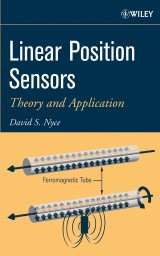Details

Linear Position Sensors
Theory and Application1. Aufl.
|
124,99 € |
|
| Verlag: | Wiley |
| Format: | |
| Veröffentl.: | 17.02.2004 |
| ISBN/EAN: | 9780471474272 |
| Sprache: | englisch |
| Anzahl Seiten: | 184 |
DRM-geschütztes eBook, Sie benötigen z.B. Adobe Digital Editions und eine Adobe ID zum Lesen.
Beschreibungen
* Sensor technology is an increasingly important area of research<br> * This will be the only book entirely devoted to the topic
Preface.<br> <br> 1. Sensor Definitions and Conventions.<br> <br> 1.1 Is It a Sensor or a Transducer?<br> <br> 1.2 Position versus Displacement.<br> <br> 1.3 Absolute or Incremental Reading.<br> <br> 1.4 Contact or Contactless Sensing and Actuation.<br> <br> 1.5 Linear and Angular Configurations.<br> <br> 1.6 Application versus Sensor Technology.<br> <br> 2. Specifications.<br> <br> 2.1 About Position Sensor Specifications.<br> <br> 2.2 Measuring Range.<br> <br> 2.3 Zero and Span.<br> <br> 2.4 Repeatability.<br> <br> 2.5 Nonlinearity.<br> <br> 2.6 Hysteresis.<br> <br> 2.7 Calibrated Accuracy.<br> <br> 2.8 Drift.<br> <br> 2.9 What Does All This about Accuracy Mean to Me?<br> <br> 2.10 Temperature Effects.<br> <br> 2.11 Response Time.<br> <br> 2.12 Output Types.<br> <br> 2.13 Shock and Vibration.<br> <br> 2.14 EMI/EMC.<br> <br> 2.15 Power Requirements.<br> <br> 2.16 Intrinsic Safety, Explosion Proofing, and Purging.<br> <br> 2.17 Reliability.<br> <br> 3. Resistive Sensing.<br> <br> 3.1 Resistive Position Transducers.<br> <br> 3.2 Resistance.<br> <br> 3.3 History of Resistive Linear Position Transducers.<br> <br> 3.4 Linear Position Transducer Design.<br> <br> 3.5 Resistive Element.<br> <br> 3.6 Wiper.<br> <br> 3.7 Linear Mechanics.<br> <br> 3.8 Signal Conditioning.<br> <br> 3.9 Advantages and Disadvantages.<br> <br> 3.10 Performance Specifications.<br> <br> 3.11 Typical Performance Specifications and Applications.<br> <br> 4. Capacitive Sensing.<br> <br> 4.1 Capacitive Position Transducers.<br> <br> 4.2 Capacitance.<br> <br> 4.3 Dielectric Constant.<br> <br> 4.4 History of Capacitive Sensors.<br> <br> 4.5 Capacitive Position Transducer Design.<br> <br> 4.6 Electronic Circuits for Capacitive Transducers.<br> <br> 4.7 Guard Electrodes.<br> <br> 4.8 EMI/RFI.<br> <br> 4.9 Typical Performance Specifications and Applications.<br> <br> 5. Inductive Sensing.<br> <br> 5.1 Inductive Position Transducers.<br> <br> 5.2 Inductance.<br> <br> 5.3 Permeability.<br> <br> 5.4 History of Inductive Sensors.<br> <br> 5.5 Inductive Position Transducer Design.<br> <br> 5.6 Coil.<br> <br> 5.7 Core.<br> <br> 5.8 Signal Conditioning.<br> <br> 5.9 Advantages.<br> <br> 5.10 Typical Performance Specifications and Applications.<br> <br> 6. The LVDT.<br> <br> 6.1 LVDT Position Transducers.<br> <br> 6.2 History of the LVDT.<br> <br> 6.3 LVDT Position Transducer Design.<br> <br> 6.4 Coils.<br> <br> 6.5 Core.<br> <br> 6.6 Carrier Frequency.<br> <br> 6.7 Demodulation.<br> <br> 6.8 Signal Conditioning.<br> <br> 6.9 Advantages.<br> <br> 6.10 Typical Performance Specifications and Applications.<br> <br> 7. The Hall Effect.<br> <br> 7.1 Hall Effect Transducers.<br> <br> 7.2 The Hall Effect.<br> <br> 7.3 History of the Hall Effect.<br> <br> 7.4 Hall Effect Position Transducer Design.<br> <br> 7.5 Hall Effect Element.<br> <br> 7.6 Electronics.<br> <br> 7.7 Linear Arrays.<br> <br> 7.8 Advantages.<br> <br> 7.9 Typical Performance Specifications and Applications.<br> <br> 8. Magnetoresistive Sensing.<br> <br> 8.1 Magnetoresistive Transducers.<br> <br> 8.2 Magnetoresistance.<br> <br> 8.3 History of Magnetoresistive Sensors.<br> <br> 8.4 Magnetoresistive Position Transducer Design.<br> <br> 8.5 Magnetoresistive Element.<br> <br> 8.6 Linear Arrays.<br> <br> 8.7 Electronics.<br> <br> 8.8 Advantages.<br> <br> 8.9 Typical Performance Specifications and Applications.<br> <br> 9. Magnetostrictive Sensing.<br> <br> 9.1 Magnetostrictive Transducers.<br> <br> 9.2 Magnetostriction.<br> <br> 9.3 History of Magnetostrictive Sensors.<br> <br> 9.4 Magnetostrictive Position Transducer Design.<br> <br> 9.5 Waveguide.<br> <br> 9.6 Position Magnet.<br> <br> 9.7 Pickup Devices.<br> <br> 9.8 Damp.<br> <br> 9.9 Electronics.<br> <br> 9.10 Advantages.<br> <br> 9.11 Typical Performance Specifications.<br> <br> 9.12 Application.<br> <br> 10. Encoders.<br> <br> 10.1 Linear Encoders.<br> <br> 10.2 History of Encoders.<br> <br> 10.3 Construction.<br> <br> 10.4 Absolute versus Incremental Encoders.<br> <br> 10.5 Optical Encoders.<br> <br> 10.6 Magnetic Encoders.<br> <br> 10.7 Quadrature.<br> <br> 10.8 Binary versus Gray Code.<br> <br> 10.9 Electronics.<br> <br> 10.10 Advantages.<br> <br> 10.11 Typical Performance Specification and Applications.<br> <br> References.<br> <br> Index.
DAVID S. NYCE is a Divisional General Manager and Director of Technology for the Sensors Group of MTS Systems Corporation in Eden Prairie, Minnesota, with an office in Cary, North Carolina. Having received the degrees of BSEE and MBA, he has spent the past twenty years developing sensors of many types for military, industrial, commercial, and automotive use.
The first complete resource on the theory and application of linear position sensor technology<br> <br> Sensor technology is an increasingly important area of research, as position sensors are being applied more and more to commercial, industrial, and automotive products and equipment. Linear Position Sensors: Theory and Application explains the theory behind the various technologies used and illustrates how they are implemented in practice.<br> <br> Readers will gain valuable insight into the complexities behind:<br> * Sensor specification, design, and application criteria<br> * Resistive sensors<br> * Capacitive sensors<br> * Inductive sensors<br> * LVDT sensors<br> * Hall effect sensors<br> * Magnetoresistive sensors<br> * Magnetostrictive sensors<br> * Linear encoders<br> <br> A recognized expert with more than two decades of professional experience in sensor development, the author provides all the necessary information for engineers or students of engineering to determine the optimum technology to use for a particular need and how to apply it.


















